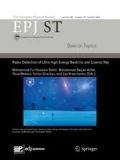Abstract
A problem of the study of underlying mechanisms for structural transformations in coupled multicomponent biological systems is considered. We focus on the case of two coupled subunits, which, being isolated, exhibit chaotic modes. We use the Hassell map as a conceptual model for subunits. A variety of non-equilibrium mono- and multistable oscillatory regimes with in-phase and anti-phase synchronization in the coupled system is described. An impact of random disturbances on the these regimes is studied. High sensitivity to noise causing stochastic transformations from anti-phase to in-phase synchronization is investigated. We show how such transformations of the synchronization modes are accompanied by transitions from order to chaos.







Similar content being viewed by others
Data availability statement
Data sharing not applicable to this article as no datasets were generated or analyzed during the current study.
Change history
16 August 2023
A Correction to this paper has been published: https://doi.org/10.1140/epjs/s11734-023-00958-7
References
R.E. Amritkar, S. Jalan, Self-organized and driven phase synchronization in coupled map networks. Phys. A 321(1), 220–225 (2003). https://doi.org/10.1016/S0378-4371(02)01750-8
S. Boccaletti, A.N. Pisarchik, C.I. del Genio, A. Amann, Synchronization: From Coupled Systems to Complex Networks (Cambridge University Press, Cambridge, 2018)
S. Jalan, A. Kumar, I. Leyva, Explosive synchronization in frequency displaced multiplex networks. Chaos 29(4), 041102 (2019). https://doi.org/10.1063/1.5092226
Y.A. Kuznetsov, Elements of Applied Bifurcation Theory (Springer, Berlin, 2004)
G. Tanaka, M.A.F. Sanjuán, K. Aihara, Crisis-induced intermittency in two coupled chaotic maps: towards understanding chaotic itinerancy. Phys. Rev. E 71, 016219 (2005). https://doi.org/10.1103/PhysRevE.71.016219
A. Pikovsky, M. Rosenblum, J. Kurths, Synchronization: A Universal Concept in Nonlinear Sciences (Cambridge University Press, Cambridge, 2001)
F. Hellmann, P. Schultz, P. Jaros, R. Levchenko, T. Kapitaniak, J. Kurths, Y. Maistrenko, Network-induced multistability through lossy coupling and exotic solitary states. Nat. Commun. 11, 592 (2020). https://doi.org/10.1038/s41467-020-14417-7
I. Bashkirtseva, L. Ryashko, Chaotic transients, riddled basins, and stochastic transitions in coupled periodic logistic maps. Chaos 31, 053101 (2021). https://doi.org/10.1063/5.0050613
N.F. Rulkov, Regularization of synchronized chaotic bursts. Phys. Rev. Lett. 86, 183–186 (2001). https://doi.org/10.1103/PhysRevLett.86.183
G. Tanaka, B. Ibarz, M.A.F. Sanjuan, K. Aihara, Synchronization and propagation of bursts in networks of coupled map neurons. Chaos 16(1), 013113 (2006). https://doi.org/10.1063/1.2148387
Z. Wang, H. Tian, O. Krejcar, H. Namazi, Synchronization in a network of map-based neurons with memristive synapse. Eur. Phys. J. Spec. Top. (2022). https://doi.org/10.1140/epjs/s11734-022-00691-7
M.N. Kuperman, M.F. Laguna, G. Abramson, J.A. Monjeau, J.L. Lanata, Metapopulation oscillations from satiation of predators. Phys. A 527, 121288 (2019). https://doi.org/10.1016/j.physa.2019.121288
A. Belyaev, I. Bashkirtseva, L. Ryashko, Stochastic variability of regular and chaotic dynamics in 2D metapopulation model. Chaos Solitons Fract. 151, 111270 (2021). https://doi.org/10.1016/j.chaos.2021.111270
D.S. Goldobin, A. Pikovsky, Synchronization and desynchronization of self-sustained oscillators by common noise. Phys. Rev. E 71, 045201 (2005). https://doi.org/10.1103/PhysRevE.71.045201
S. Gil, Y. Kuramoto, A.S. Mikhailov, Common noise induces clustering in populations of globally coupled oscillators. EPL 88(6), 60005 (2009). https://doi.org/10.1209/0295-5075/88/60005
K.H. Nagai, H. Kori, Noise-induced synchronization of a large population of globally coupled nonidentical oscillators. Phys. Rev. E 81, 065202 (2010). https://doi.org/10.1103/PhysRevE.81.065202
A. Buscarino, L.V. Gambuzza, M. Porfiri, L. Fortuna, M. Frasca, Robustness to noise in synchronization of complex networks. Sci. Rep. 3, 2026 (2013). https://doi.org/10.1038/srep02026
A.N. Pisarchik, I.A. Bashkirtseva, L.B. Ryashko, Noise-induced quasiperiodicity in a ring of unidirectionally-coupled nonidentical maps. Phys. Lett. A 383(14), 1571–1577 (2019). https://doi.org/10.1016/j.physleta.2019.02.029
I. Bashkirtseva, L. Ryashko, Stochastic deformations of coupling-induced oscillatory regimes in a system of two logistic maps. Phys. D (2020). https://doi.org/10.1016/j.physd.2020.132589
S. Metta, A. Provenzale, E.A. Spiegel, On-off intermittency and coherent bursting in stochastically-driven coupled maps. Chaos Solitons Fract. 43(1), 8–14 (2010). https://doi.org/10.1016/j.chaos.2010.06.001
J. Emenheiser, A. Chapman, M. Pósfai, J.P. Crutchfield, M. Mesbahi, R.M. D’Souza, Patterns of patterns of synchronization: noise induced attractor switching in rings of coupled nonlinear oscillators. Chaos 26(9), 094816 (2016). https://doi.org/10.1063/1.4960191
I. Tsvetkov, I. Bashkirtseva, L. Ryashko, Stochastic transformations of multi-rhythmic dynamics and order-chaos transitions in a discrete 2D model. Chaos 31, 063121 (2021). https://doi.org/10.1063/5.0054679
I. Bashkirtseva, L. Ryashko, A.N. Pisarchik, Stochastic transitions between in-phase and anti-phase synchronization in coupled map-based neural oscillators. Commun. Nonlinear Sci. Numer. Simul. 95, 105611 (2021). https://doi.org/10.1016/j.cnsns.2020.105611
A.N. Pisarchik, A.E. Hramov, Multistability in Physical and Living Systems (Springer, Berlin, 2022)
M.P. Hassell, Density-dependence in single-species populations. J. Anim. Ecol. 44, 283–295 (1975). https://doi.org/10.2307/3863
M.P. Hassell, J.H. Lawton, R.M. May, Patterns of dynamical behaviour in single-species populations. J. Anim. Ecol. 45, 471–486 (1976). https://doi.org/10.2307/3886
M. Vellekoop, G. Högnäs, A unifying framework for chaos and stochastic stability in discrete population models. J. Math. Biol. 35, 557–588 (1997). https://doi.org/10.1007/s002850050066
I. Bashkirtseva, Crises, noise, and tipping in the Hassell population model. Chaos 28, 033603 (2018). https://doi.org/10.1063/1.4990007
M. Anazawa, Inequality in resource allocation and population dynamics models. R. Soc. Open Science 6(7), 182178 (2019). https://doi.org/10.1098/rsos.182178
G. Grebogi, E. Ott, J.A. Yorke, Crises, sudden changes in chaotic attractors, and transient chaos. Phys. D 7(1), 181–200 (1983). https://doi.org/10.1016/0167-2789(83)90126-4
Acknowledgements
The research funding from the Ministry of Science and Higher Education of the Russian Federation (Ural Federal University Program of Development within the Priority-2030 Program) is gratefully acknowledged.
Author information
Authors and Affiliations
Corresponding author
Additional information
The original online version of this article was revised: The given and family names of the authors were interchanged.
Rights and permissions
Springer Nature or its licensor (e.g. a society or other partner) holds exclusive rights to this article under a publishing agreement with the author(s) or other rightsholder(s); author self-archiving of the accepted manuscript version of this article is solely governed by the terms of such publishing agreement and applicable law.
About this article
Cite this article
Bashkirtseva, I., Ryashko, L. Structural and stochastic transformations in a system of coupled populations. Eur. Phys. J. Spec. Top. 232, 1247–1252 (2023). https://doi.org/10.1140/epjs/s11734-022-00762-9
Received:
Accepted:
Published:
Issue Date:
DOI: https://doi.org/10.1140/epjs/s11734-022-00762-9




